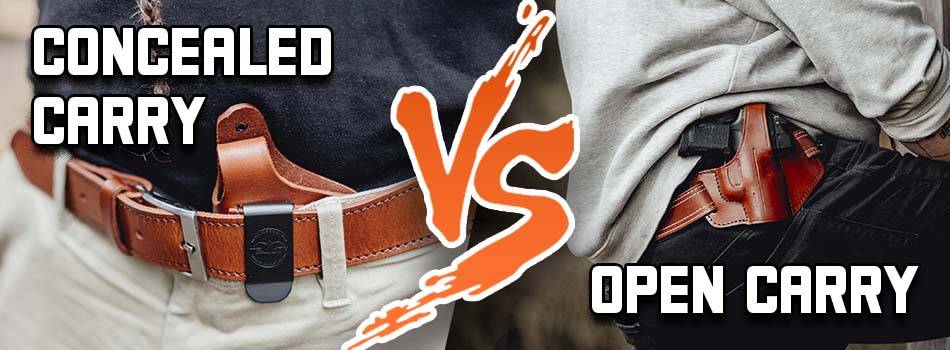
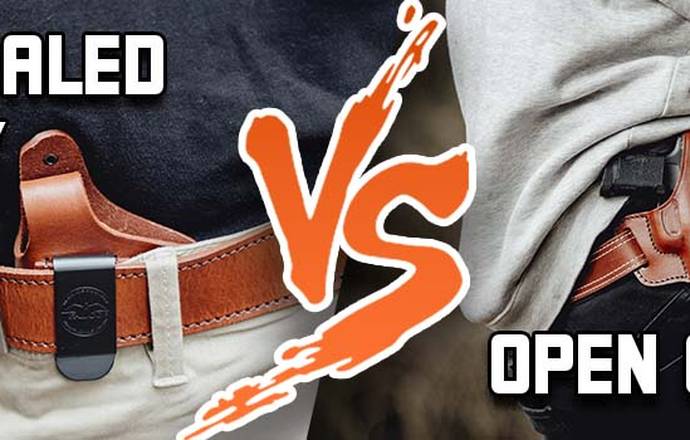
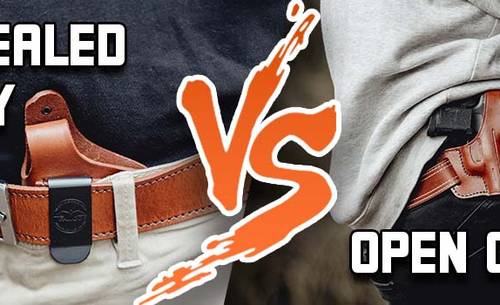
Table of Contents
The debate between open carry and concealed carry is as old as the laws that govern them.
In the world of responsible gun ownership and self-defense, choosing how to carry your weapon is not merely a matter of legal right but also of strategic preference and situational necessity.
What we want to do here is explore the implications, advantages, and drawbacks of each method.
Yes, the right choice of open carry vs concealed carry heavily depends on personal circumstances and the specific context in which you find yourself. But there’s much more to it than just that.
Let’s take a look.
THE FUNDAMENTALS OF CARRY METHODS
The concept of carrying weapons for self-defense has a long history and is deeply intertwined with the legal and cultural tapestry of societies around the world.
In the United States, the legal framework governing open and concealed carry varies significantly across state lines, creating a complex mosaic of regulations that gun owners must navigate.
OPEN CARRY VS CONCEALED CARRY—WHAT DOES IT MEAN?
Open carry refers to wearing a firearm visibly, typically holstered on one's belt, while concealed carry involves hiding the weapon on one's person, often under clothing.
Each method has its roots in the early days of the republic, evolving through legal challenges and societal changes to form the current standards and practices.
OPEN CARRY INSIGHTS
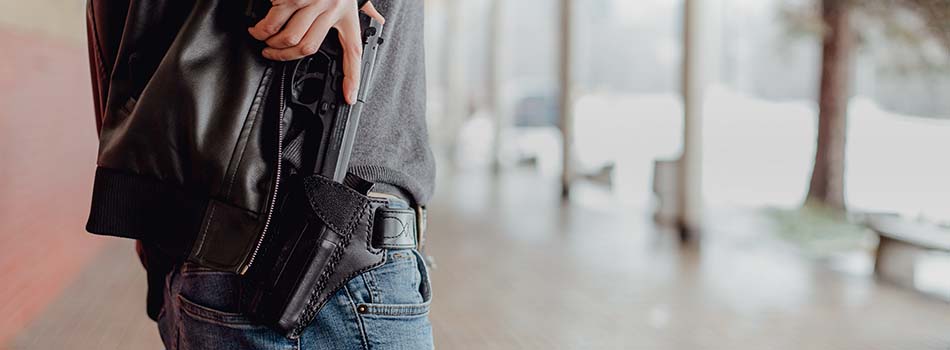


Open carry stands out for its straightforwardness — a firearm carried openly signals a clear message of self-defense capability. Legally, open carry is permitted in many states without the need for a special permit, though this is subject to change based on local laws and regulations.
It's seen by some (myself included) as a visible assertion of Second Amendment rights.
In certain scenarios, such as hiking in remote areas or when engaged in specific outdoor activities, open carry might be more appropriate, offering ease of access and a deterrent to potential threats.
However, the visibility of the weapon can also draw unwanted attention, potentially making the carrier a first target in a criminal's strategy.
The lack of a retention device on many open carry holsters further complicates this issue, as it could allow unwanted easy access to the weapon. Here are two Beretta 92 holster examples of what we mean: our Beretta 92 Belt Tunnel Holster vs our Beretta 92 Open Top Belt Holster.
THE CONCEALED CARRY APPROACH
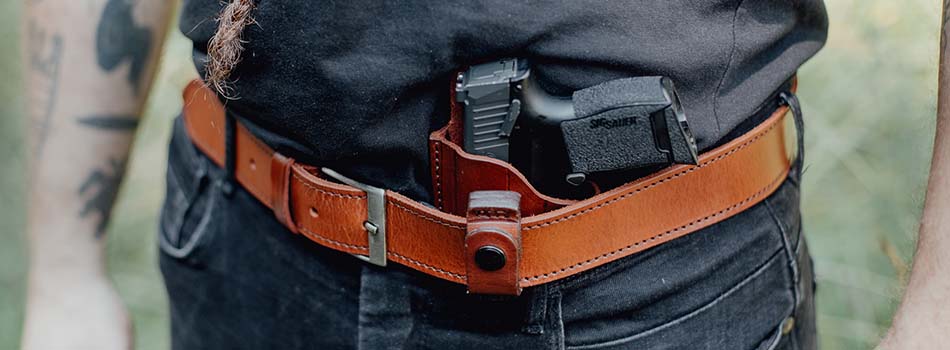


Concealed carry, by contrast, offers the element of surprise and minimizes any public concern or panic that might arise from seeing a firearm.
This method requires more thought into clothing and holster choice to effectively conceal the weapon while ensuring it remains accessible (a chest holster is a good example). States typically require a permit for concealed carry, underscoring the need for gun owners to undergo training and demonstrate proficiency.
AVOIDING UNWANTED ATTENTION
The benefits of concealed carry extend beyond the tactical. Concealing a firearm reduces the risk of becoming a target and avoids the social stigma or panic that might accompany the sight of a gun in public. Yet, this method is not without its drawbacks.
Concealment can complicate quick access to the firearm in urgent situations, and legal restrictions may limit where and how you can carry concealed.
OPEN VS. CONCEALED: A COMPARATIVE ANALYSIS
When comparing open carry and concealed carry, each presents unique tactical advantages, comfort levels, legal boundaries, and social implications.
- The myth that open carry always deters criminal activity is not universally true; in some cases, it may invite challenges or unwanted attention
- Conversely, the belief that concealed carry is always the strategic high ground may not hold in situations where a visible deterrent could prevent a threat from escalating
Tactical Advantage: Concealed carry offers the element of surprise, crucial in self-defense scenarios, whereas open carry can act as a visible deterrent to potential threats. However, the visibility of open carry may also invite confrontations or attempts to disarm.
Comfort and Practicality: Open carry can be more comfortable and accessible, especially in environments or climates unfriendly to concealment clothing. Concealed carry requires more thought into garment selection and may restrict quick access to the firearm.
Legal Considerations: Open carry laws vary significantly, with some states allowing it without a permit, whereas concealed carry almost universally requires a permit, demonstrating proficiency and knowledge of gun laws.
Social Impact: Open carry can provoke public concern, especially in densely populated urban areas, potentially leading to law enforcement interactions. Concealed carry minimizes public awareness and potential alarm but requires the carrier to navigate the complexities of remaining discreet.
OPEN VS. CONCEALED: MAKING THE INFORMED DECISION
Choosing the right carry method is a deeply personal decision that should be influenced by a thoughtful assessment of one's lifestyle, the specific needs of self-defense, legal constraints, and a commitment to ongoing training.
Consider the following:
Personal Lifestyle and Environment: Your daily activities, the places you frequent, and the general attitude towards guns in your community should influence your choice.
Specific Needs and Legal Requirements: Evaluate the need for discretion based on your environment and adhere strictly to state and local laws regarding open and concealed carry.
Training and Proficiency: Regardless of choice, achieving proficiency with your firearm is paramount. Regular training, including scenario-based drills for both open and concealed carry, is crucial.
OPEN VS. CONCEALED: TRENDS AND LEGAL CHANGES
Recent legal changes, including Supreme Court decisions and adjustments to state laws, have significantly influenced the landscape of both open and concealed carry in the United States.
A noticeable trend is the expansion of concealed carry rights and the clarification of open carry laws, reflecting a growing acceptance of the right to carry for self-defense.
APPLICATIONS ON THE RISE
The surge in permit applications following landmark legal decisions underscores the public's keen interest in exercising their Second Amendment rights responsibly. Moreover, the increasing availability of concealed carry courses and information on legal requirements signals a shift towards educated, law-abiding gun ownership.
OPEN CARRY VS. CONCEALED CARRY: CONCLUSION
In the debate between open carry and concealed carry, there is no one-size-fits-all answer. The choice hinges on a complex interplay of tactical considerations, personal comfort, legal stipulations, and societal impacts.
What remains constant, however, is the necessity for responsible gun ownership, informed by continuous education and proficient training.
By carefully weighing the advantages and challenges of each carry method against your specific circumstances, you can make an informed decision that best serves your self-defense needs while adhering to legal requirements and promoting a positive image of gun ownership.
CARRY WITH CONFIDENCE WITH CRAFT HOLSTERS
Carrying for self-protection is no joke. So choose a method of carrying that gives you the confidence you need to get the job done should the need ever arise.
Craft Holsters makes dedicated holsters that fit a huge variety of different handguns—each one tailored to give you a carry method that suits your needs.
Check out our stock right away. The perfect carry holster is waiting for you right now.
DO YOU FANCY SOME MORE LIGHT READING? THEN CARRY ON WITH THESE ARTICLES
STRIKER FIRED VS HAMMER FIRED: CHOOSING THE RIGHT FIREARM FOR YOU
SINGLE ACTION VS DOUBLE ACTION: WHAT KIND OF ACTION FITS YOU?
REVOLVER VS SEMI-AUTO: MAKING THE RIGHT CHOICE FOR SELF-DEFENSE
